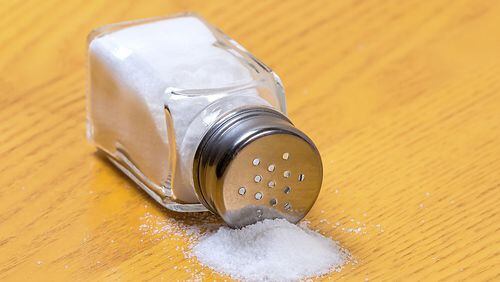Salt has gotten so complicated. Used to be, the worst you’d hear about it was poor Lot’s wife being turned into a pillar of the stuff.
But now, every time we contemplate lifting the shaker to douse our eggs, each time we glance at a food label or eat a pickle, we feel guilt pangs, hearing echoes of “too much sodium causes (insert negative medical condition here).”
The American Heart Association’s Sodium Reduction Initiative urges us to #BreakUpWithSalt, limiting our average daily intake of sodium to 2,300 milligrams from our current 3,400. (To put this into perspective, a McDonald’s Artisan Grilled Chicken Sandwich and a small order of fries contain about 1,270 milligrams.)
The New England Journal of Medicine reported that reducing sodium by 400 milligrams a day could not only save 28,000 lives, it could also save $7 billion in annual health care costs.
Then we have Dr. James DiNicolantonio, a cardiovascular research scientist who wrote a book called “The Salt Fix: Why the Experts Got It All Wrong—and How Eating More Could Save Your Life” (Harmony Books; $26.99). Too little salt, he says, can lead to weight gain, chronic kidney disease, elevated bad cholesterol and increased blood pressure and heart rate.
So should we try to eliminate it entirely? Why do we need it anyway? Here’s what red-blooded Americans need to know about the white stuff that’s been around since practically the beginning of time (see Genesis).
Sodium is important.
Not only is this mineral important, it’s “super important for our survival,” says Nancy DiMarco, director of the Institute for Women’s Health at Texas Woman’s University and a professor in the school’s department of nutrition and food sciences.
“It helps to regulate nerve contractions, nerve transitions, muscle contractions and facilitates the uptake of glucose into tissue and muscle. It’s responsible for electrolyte balance, for blood pressure. It’s like water and glucose, which I tell students are important for survival.”
It’s homeostatically regulated.
That’s a fancy way of saying that if the sodium level is too high, “our bodies have the mechanism to bring it down,” DiMarco says. “If it’s too low, we have the mechanisms to bring it up.”
In other words, if we have too much salt in our bodies, our bodies get rid of it through urination. Too little, and our kidneys reabsorb it into our bloodstream.
“Sugar won’t do that,” says DiNicolantonio, adding that sugar is more of a dietary culprit than salt. “When you consume more sugar, you crave more.”
The catch is …
When we’ve consumed so much sodium that this kidney flushing is repeated over and over, our kidneys can get worn out, explains Jane Brody in The New York Times. That can result in “increased pressure put on blood vessels and excess fluid surrounding body tissues,” she writes.
That said …
“I don’t think sodium is the issue,” DiMarco says. “There is an association between excess sodium in the diet and the development of hypertension, but there’s never been cause and effect.”
In his book, DiNicolantonio writes that “there was never any sound scientific evidence” that salt increases blood pressure. But Dr. Wanpen Vongpatanasin, director of the Hypertension Section at UT Southwestern Medical Center, disagrees.
“There are multiple randomized studies that show that lowering salt intake reduces blood pressure in patients with both mild, uncomplicated hypertension and resistant hypertension,” Vongpatanasin, holder of the Norman and Audrey Kaplan Chair in Hypertension, writes in an email. “Reducing sodium intake has been shown to decrease stiffness of the arteries, which is another major risk factor for stroke and cardiovascular events.”
DiMarco blames Americans’ unhealthy diet in general for the three major causes of death: hypertension, cardiovascular disease and stroke. “I think we’d go so much further by altering how we eat instead of focusing on a single nutrient like sodium. I get so frustrated with so many of these things that eliminate whole food groups, and when you do that, you eliminate a whole bunch of nutrients you can’t find in other types of food.”
Case in point:
Iodine is a mineral that our bodies need, and it’s in iodized table salt. But when salt started getting a bad rap, people stopped buying it and, thus, were cutting out iodine.
“We have seen since the 1980s that iodine intake has decreased by almost 100 percent,” says DiMarco. She has studied this topic extensively and is in the process of writing a review paper on a study TWU did of 110 women, 90 percent of whom didn’t know they should be buying iodized salt.
“Our concern is that iodine is super important in the reproductive years, ages 18 to 45,” she says. “In the first three months when the brain develops, it’s absolutely essential the fetus be receiving adequate amounts of iodine because of its connection with cognitive abilities.”
Salt shakers aren’t the problem.
Salt, DiMarco says, has “gotten a bad rap because of where it finds itself, which is in all these processed foods.”
According to webmd.com, 5 percent of the sodium we consume comes from salt added during cooking, 6 percent from salting food at the table and 12 percent from foods that are natural sources of sodium. The remaining 75 percent comes from processed foods. For example, a half-cup serving of Campbell’s Chicken Noodle Soup has 890 milligrams of sodium, which is more than a third of the recommended daily requirement. And who among us eats only a half-cup of soup?
Eating diets low in salt, DiNicolantonio says, creates cravings and leads people “to eat all these processed foods to get salt. They should be using real salt on real food.”
No need to go overboard
“For the most part, the addition of salt that chefs and cooks do is to enhance flavor already existing,” says Chris LaLonde, culinary coordinator and chef instructor at El Centro’s Food and Hospitality Institute. “That’s how we think of it, as a flavor enhancer, not a flavor in itself.”
Adds DiNicolantonio: “We’re more likely to eat healthier foods if we add salt.”
And finally, the all-around health secret
“The answer to everything,” DiMarco says, “is to eat fruits and vegetables. I tell my students the practice of good nutrition is not rocket science.
“It doesn’t take a genius to eat well. You just have to be conscientious and mindful of what you’re putting in your mouth every day.”
Which leads to these tips:
Eat more fresh fruits and vegetables.
Check labels. Aim for those with less than 140 milligrams of sodium per serving. Top sources of salt in the American diet, says Nancy DiMarco, are bread and rolls, pizza, cold cuts and cured meats.
Eat more potassium. “If we could balance our sodium with more potassium, we’d be a lot healthier,” DiMarco says. Good sources include bananas, apricots, spinach and potatoes.
Cook at home. Restaurant meals usually contain high amounts of sodium.
About the Author






